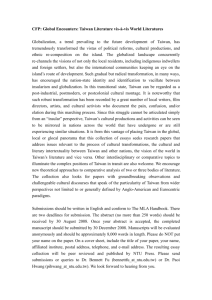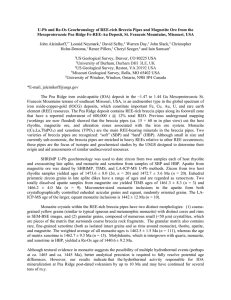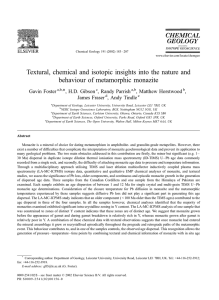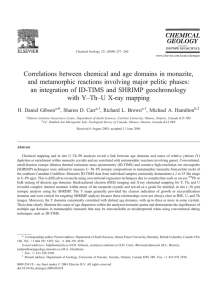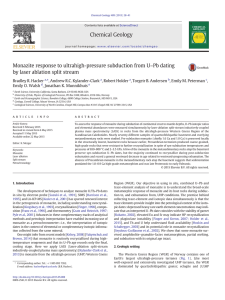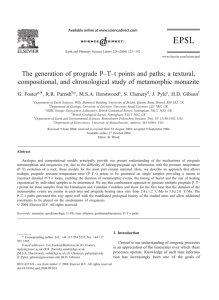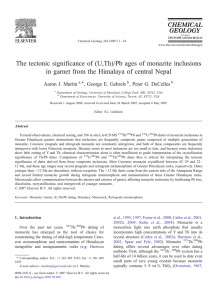Nd-Sr Isotopic and Zircon U-Pb SHRIMP study of the Precambrian
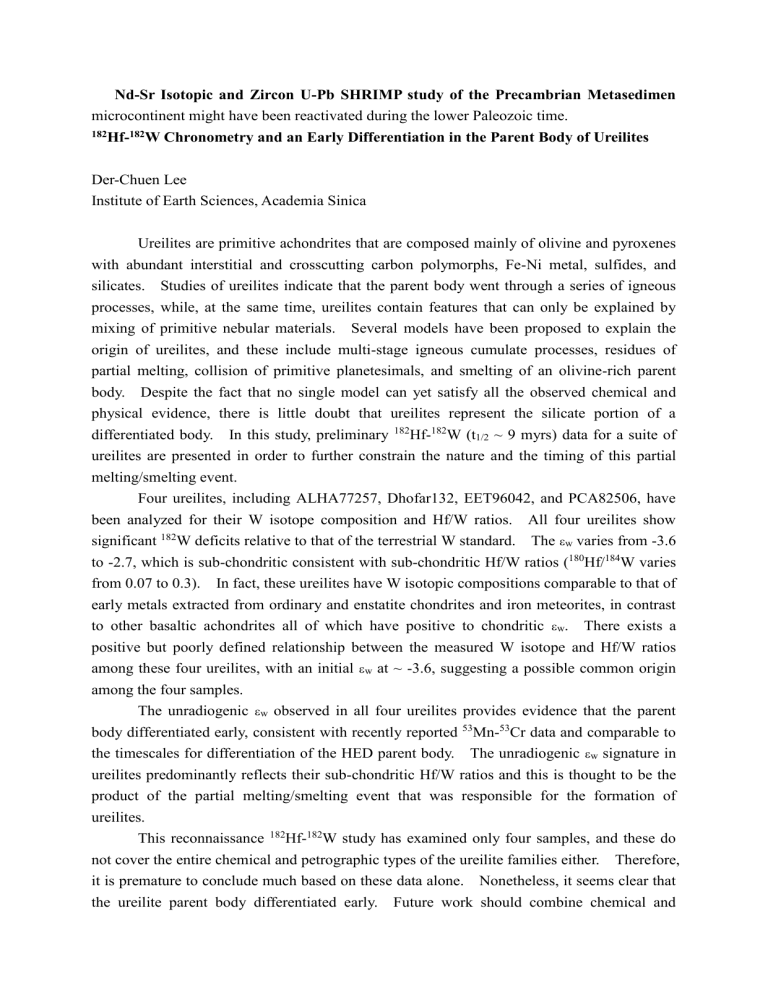
Nd-Sr Isotopic and Zircon U-Pb SHRIMP study of the Precambrian Metasedimen microcontinent might have been reactivated during the lower Paleozoic time.
182 Hf182 W Chronometry and an Early Differentiation in the Parent Body of Ureilites
Der-Chuen Lee
Institute of Earth Sciences, Academia Sinica
Ureilites are primitive achondrites that are composed mainly of olivine and pyroxenes with abundant interstitial and crosscutting carbon polymorphs, Fe-Ni metal, sulfides, and silicates. Studies of ureilites indicate that the parent body went through a series of igneous processes, while, at the same time, ureilites contain features that can only be explained by mixing of primitive nebular materials. Several models have been proposed to explain the origin of ureilites, and these include multi-stage igneous cumulate processes, residues of partial melting, collision of primitive planetesimals, and smelting of an olivine-rich parent body. Despite the fact that no single model can yet satisfy all the observed chemical and physical evidence, there is little doubt that ureilites represent the silicate portion of a differentiated body. In this study, preliminary
182
Hf-
182
W (t
1/2
~ 9 myrs) data for a suite of ureilites are presented in order to further constrain the nature and the timing of this partial melting/smelting event.
Four ureilites, including ALHA77257, Dhofar132, EET96042, and PCA82506, have been analyzed for their W isotope composition and Hf/W ratios. All four ureilites show significant
182
W deficits relative to that of the terrestrial W standard. The w
varies from -3.6 to -2.7, which is sub-chondritic consistent with sub-chondritic Hf/W ratios (
180
Hf/
184
W varies from 0.07 to 0.3). In fact, these ureilites have W isotopic compositions comparable to that of early metals extracted from ordinary and enstatite chondrites and iron meteorites, in contrast to other basaltic achondrites all of which have positive to chondritic w
. There exists a positive but poorly defined relationship between the measured W isotope and Hf/W ratios among these four ureilites, with an initial w
at ~ -3.6, suggesting a possible common origin among the four samples.
The unradiogenic w
observed in all four ureilites provides evidence that the parent body differentiated early, consistent with recently reported
53
Mn-
53
Cr data and comparable to the timescales for differentiation of the HED parent body. The unradiogenic w
signature in ureilites predominantly reflects their sub-chondritic Hf/W ratios and this is thought to be the product of the partial melting/smelting event that was responsible for the formation of ureilites.
This reconnaissance
182
Hf-
182
W study has examined only four samples, and these do not cover the entire chemical and petrographic types of the ureilite families either. Therefore, it is premature to conclude much based on these data alone. Nonetheless, it seems clear that the ureilite parent body differentiated early. Future work should combine chemical and
petrographic evidence to study ureilites of different chemical and petrographic types, such that a more complete picture to the evolution history of the ureilite parent body can be obtained.
Provenance of Beach Sands in Two Sides of the Taiwan Strait: Constraints from CHIME
Monazite Ages
Cheng-Hong Chen
1
, Hsueh-yu Lu
2
and Wayne Lin
3
1. Department of Geosciences, National Taiwan University, Taipei 106, Taiwan
2. Department of Earth Sciences, National Chung-Cheng University, Chiayi, Taiwan
3. Energy and Resources Laboratories, Industrial Technology Research Institute, Hsinchu 310,
Taiwan
Abstract
Yellow monazites in the beach sands from Chinmen areas (E Fujian) and Hsinchu (W
Taiwan) are able to provide CHIME age information through the electron microprobe analysis, which can be used to unravel the provenance of recent sediments in two sides of the Taiwan
Strait. Samples from Chinmen areas generally give CHIME monazite ages ranging from
~180-75 Ma, although a small group of monazite falling in the range 220-180 Ma. Along with the obvious “isochron” ages of 139 Ma and 124 Ma at different sites, they are considered to represent mixed remnants of igneous and metamorphic rocks generated during the
Yanshanian orogeny in Fujian as well as rocky beaches eroded by sea waves causing physical removal of material from the beach. Since ages of 220-180 Ma, that are seldom mentioned in the SE China coastal region, were obtained either from the core or from rounded grains of monazites, overprint of Yanshanian magmatism on the Indosinian event is postulated. In the sediments from Hsinchu, further to the majority of the samples that is distributed from
430-110 Ma, a large number of monazite with the CHIME “isochron” age of 1770
60 to
1700
100 Ma is obtained. This implies that, in addition to the coastal Fujian areas, the provenance is also related to the 1.8-1.7 Ga Proterozoic basement of the Cathaysia Block and products of Caledonian, Hercynian, and Indosinian orogenesis. On the basis of regional geology and drainage patterns in relevance, Wuyishan is the most potential source area, and
materials could have been transported by the drainage system of the Mingjiang River.
(Keywords: CHIME monazite age, provenance of sediments, S China and Taiwan)







